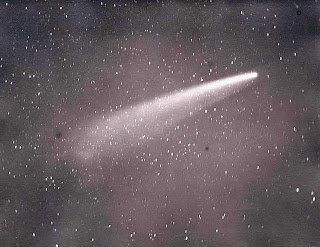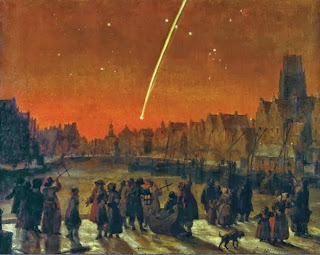In a matter of days, Comet
ISON will make its perihelion approach, coming within 750,000 miles
(a very close shave in astronomical terms) from the Sun. Both
astronomers and the general public have gone abuzz over Comet
ISON thanks
to a prediction released a year ago by NASA's
Jet Propulsion Laboratory (JPL) that stated that the comet could
reach magnitude -11.6,
or about as bright as the Full Moon. Additionally, besides being
shadow-casting bright at night, the comet would be bright enough to
easily be spotted during broad daylight.
If this were to happen, it would not be a first, but it would allow Comet ISON to join a very exclusive list of the brightest comets ever seen. To days, only 9 comets in recorded history have been bright enough to be seen in daylight. Now, in chronological order, here they are . . .
If this were to happen, it would not be a first, but it would allow Comet ISON to join a very exclusive list of the brightest comets ever seen. To days, only 9 comets in recorded history have been bright enough to be seen in daylight. Now, in chronological order, here they are . . .
Great
Comet of 1106.
The Belgian historian Sigebertus Gemblacensis completed his Chronica in 1111. In it, he wrote that on 1106 February 2 a star appeared during the daytime, between the third and ninth hours, about a cubit from the sun. The probable universal time of this observation was February 2-3. A cubit is roughly equal to one degree, meaning that the comet was in Aquarius. The comet was observed in other European countries as well as in the Orient. Some estimates credit the comet as having a tail spanning 100 degrees at peak.
The Belgian historian Sigebertus Gemblacensis completed his Chronica in 1111. In it, he wrote that on 1106 February 2 a star appeared during the daytime, between the third and ninth hours, about a cubit from the sun. The probable universal time of this observation was February 2-3. A cubit is roughly equal to one degree, meaning that the comet was in Aquarius. The comet was observed in other European countries as well as in the Orient. Some estimates credit the comet as having a tail spanning 100 degrees at peak.
Great Comet of 1680.
Even if it weren't for its amazing show, the Great
Comet of 1680 had another distinction: it was the first comet
discovered by telescope. First seen on November 14, 1680, the comet
rapidly brightened as it approached perihelion, which took place on
December 18, 1680, at which time the comet, which passed within
600,000 miles of the Sun, was reportedly bright enough to be seen
in broad daylight. Coincidentally, the Great Comet of 1680 has an
almost identical orbit to that of Comet ISON.
Great
Comet of 1743-4.
This comet was discovered simultaneously be
several astronomers in November, 1743. At the time, it was
reported as appearing as a nebulous star without a tail. By February,
1744 it was as bright as Venus and, after perihelion approach in
March, 1744, it developed a spectacular, fan-like tail with 6
prominent streaks. This 6-tailed comet was even observed before
it rose, its tail was that bright. The comet then moved into the
Southern hemisphere, where some observers credited it with a tail
spanning 90 degrees. After 2006-7's McNaught, some came to believe
that the Comet of 1743-4 was the first recorded appearance of a comet
featuring prominent dust striae.
Great
Comet of 1843.
First observed in February of 1843, the comet
rapidly brightened to the point it was seen in broad daylight at
perihelion, which brought it to about 1 angular degree (or about
830,000 miles) of the Sun. This comet was known for its extremely
long tail. At over 2 astronomical units (over 180 million miles), the
Comet of 1843 would have the longest measured tail until Comet
Hyakutake of 1996 was found to have a tail of over twice that length.
Great
Comet of September 1882 (the Super Comet).
Perhaps the brightest
comet ever seen, at peak, some estimate the Great Comet of September
1882 of having had a peak brightness of magnitude -20, rivaling that
of the Sun. Initially spotted in either late August or early
September 1882, the comet brightened rapidly as it approached
perihelion, which took place on September 17. At this time, the comet
was reported as being scarcely dimmer than the limb of the Sun,
suggesting a magnitude as bright as -20. After perihelion, the comet
quickly moved into dark skies, making it perhaps the most spectacular
comet ever seen in all of recorded history. The comet remained
visible to the naked eye for a long time, until February, 1883, with
the last confirmed sighting coming in June, 1883. This comet was also
notable in being the first great comet to have been photographed.
The
Daylight Comet of January 1910.
In 1910, comet mania was in high
gear with the anticipated return of Halley's Comet set for April.
However, in January, a surprise came about in the form of a comet
that literally burst into naked eye visibility virtually overnight.
Initially observed in the Southern Hemisphere, the comet reached
perihelion on January 17 and moved into the Northern Hemisphere
thereafter, easily out-shining Venus and having a tail possibly 50
degrees long. Thanks to appearances of Halley's Comet later that year
and the passage of decades, many recollections of the two comets were
confused when Halley's Comet reappeared in 1986, with the Daylight
Comet being falsely remembered as Halley's Comet.
Comet
Skjellerup Maristany (1927).
This comet became very bright in late, 1927, being naked-eye visible for about a month. In mid December, the comet, already notable for its yellow appearance thanks to a shedding of sodium atoms, shot into daylight visibility thanks to a forward scattering of light, provided one blocked the Sun with one's hand. The Comet reached perihelion on December 15 passing within 1.5 angular degrees of the Sun.
Comet
Ikeya Seki (1965).This comet became very bright in late, 1927, being naked-eye visible for about a month. In mid December, the comet, already notable for its yellow appearance thanks to a shedding of sodium atoms, shot into daylight visibility thanks to a forward scattering of light, provided one blocked the Sun with one's hand. The Comet reached perihelion on December 15 passing within 1.5 angular degrees of the Sun.
Initially discovered in December, 1965, initial
predictions projected a perihelion approach to within 500,000 miles
of the Sun coming in mid October and the comet reaching incredible
brightness. In this case, the comet lived up to the hype, reaching an
apparent magnitude of -10 in October, 1965, becoming visible next to
the Sun in daylight near perihelion. After the comet reappeared on
the other side of the Sun following perihelion, it sported an
extremely bright, long tail.
Comet
West (1976)
Discovered photographically in September, 1975, Comet
West was predicted to reach perihelion on February 25 of the
following year. At perihelion, observers reported the comet as being
bright enough to be seen in broad daylight. Unfortunately, despite
its spectacular appearance, comet West was largely ignored by the
non-astronomical media thanks to another comet, Kohoutek, which
failed to live up to its initial billing as 'comet of the century' in
1973.
Comet
McNaught (2006-7)
Like
West, Comet McNaught was discovered photographically about 6 months
prior to perihelion, which took place in mid-January, 2007. For
observers, it didn't take long to realize that the new discovery was
brightening rapidly and had the potential to become a 'great comet.'
Until its perihelion approach, Comet McNaught was a Northern
Hemisphere object. Even before perihelion, the comet was bright
enough to be seen in daylight. Post-perihelion and after moving into
the Southern Hemisphere sky, the comet sprouted a gigantic, dusty,
fan-like tail, the end of which was even visible in the Northern
hemisphere. In terms of measured brightness, McNaught was measured as
having a brightness of -5.5, the brightest since 1965.
So, will Comet ISON get added to this list? In the end, only time will tell. The good news: whatever happens to Comet ISON, we won't have long to wait as it makes its perihelion approach in a mere 2 days!
So, will Comet ISON get added to this list? In the end, only time will tell. The good news: whatever happens to Comet ISON, we won't have long to wait as it makes its perihelion approach in a mere 2 days!
For More Historical Astronomy
The Planet of Bethlehem?
A History of Cosmology: Prehistory to Present
Galileo's Fingers Go on Display.
Renaissance Astronomy: Part 1
Renaissance Astronomy: Part 2
Renaissance Astronomy: Part 3
The Equinox and a Magic Show from the Maya
Ancient America: the Moundbuilders
Ancient America: the Southwest
Ancient Egypt
Classical Greece
The Summer Solstice Sun and the Size of the Earth
The 1833 Leonids: History's Greatest Meteor Storm
The 10 Brightest Comets of All Time
Ben Franklin and the Truth About Daylight Savings Time
Like What You Just Read?
Why not check out other great stuff about photography, astronomy, associated gear, and how to use it.
Think someone else would find this informative (or at least entertaining)? Use the buttons below to share!
Why not check out other great stuff about photography, astronomy, associated gear, and how to use it.
Think someone else would find this informative (or at least entertaining)? Use the buttons below to share!
























What about comet Halley?
ReplyDeleteHalley's Comet has put on some good shows, but it was never a daylight comet.
ReplyDelete